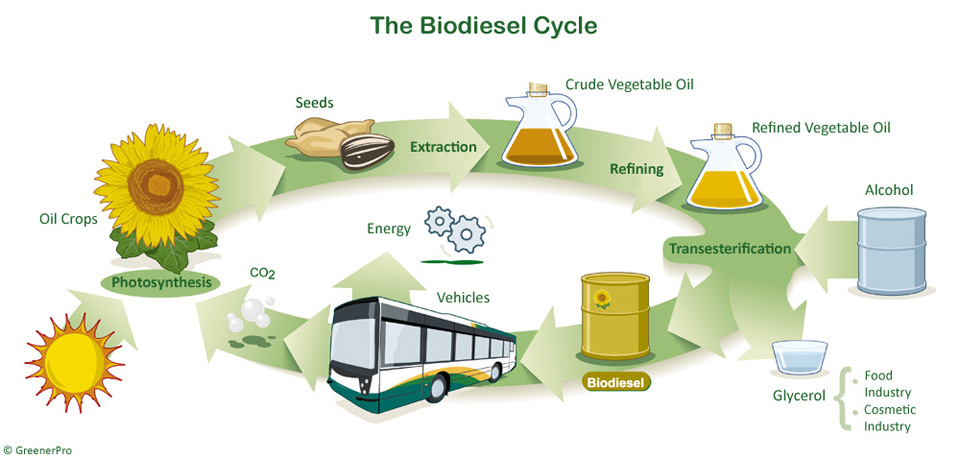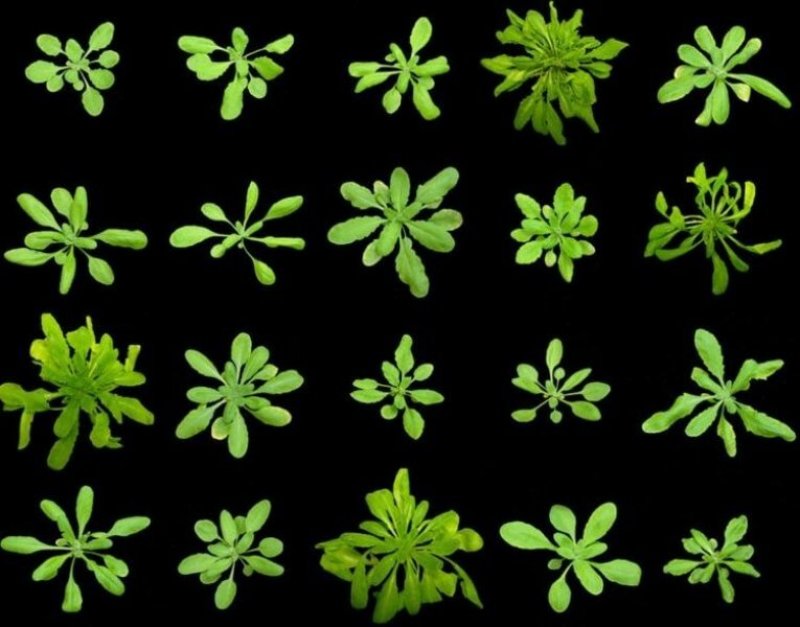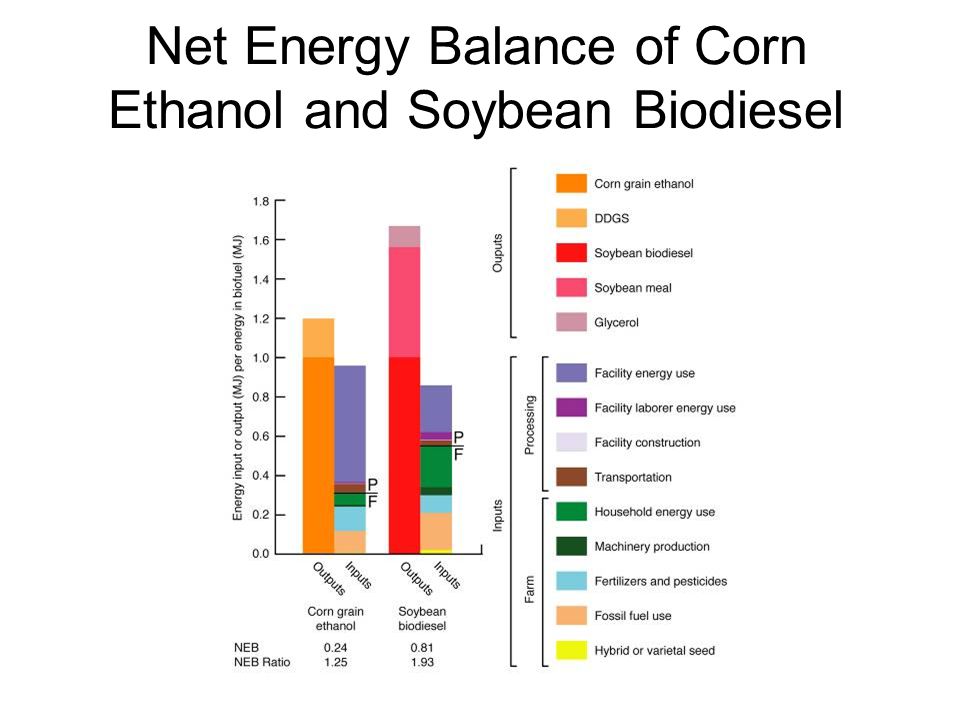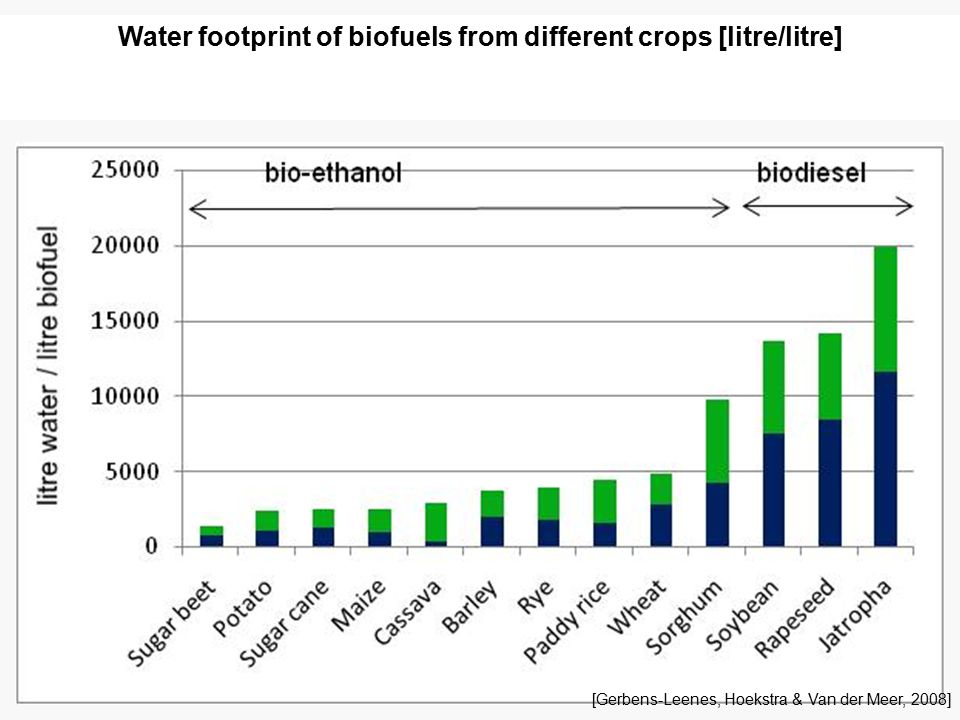The biofuels advantages and disadvantages depend entirely on its nature and how they are accessed. Biofuels refer to fuels made from plant materials. In this article, we will describe the points related to this issue. First, a brief introduction to biofuels is essential.
What Is Biofuel?
Biofuel is the fuel created through contemporary processes from biomass instead of the very gradual geological processes associated with the formation of fossil fuels, such as natural gas or oil. Biomass is plant or animal material like wood, energy crops, and waste from forests, farms, or yards utilized as fuel to generate electricity or heat.
Because biomass technically can be used directly as a fuel, sometimes the terms biomass and biofuel are used interchangeably. However, most of the time, the word biomass simply signifies the biological raw material from which the fuel is made, or some kind of thermally-chemically changed solid end product, like torrefied pellets or briquettes.
Biofuel can be produced from plants or commercial, agricultural, domestic, or industrial wastes with a biological origin. Biofuel typically involves contemporary carbon fixation, such as happens in plants or microalgae during photosynthesis. The greenhouse emission potential of biofuel varies considerably, from levels comparable to fossil fuels in some situations to negative emissions in others. The Intergovernmental Panel on Climate Change (IPCC) determines bioenergy as a renewable energy form.
The following figure shows the biodiesel cycle schematically.

Types of Biofuels
Biofuels are generally of two categories: gaseous biofuel and liquid biofuel.
Gaseous Biofuel
Biogas and syngas are two types of gaseous biofuels.
Biogas and Biomethane
Biogas is methane generated in the process of anaerobic digestion of organic matter by anaerobes. With the removal of impurities from biogas, biomethane is produced.
Syngas
Syngas is a mix of carbon monoxide, hydrogen, and other hydrocarbons, which is produced by the partial combustion of biomass. Partial combustion is fuel-burning with insufficient oxygen to convert the biomass entirely to carbon dioxide and water. Syngas can be utilized to make methanol, DME, and hydrogen.
Liquid Biofuel
The most common types of liquid biofuels are bioethanol and biodiesel.
Bioethanol
Bioethanol is a type of alcohol produced by fermentation, often from carbohydrates made in sugar or starchy crops like corn, sugarcane, or sweet sorghum. Cellulosic biomass obtained from non-food sources, including trees and grasses, is also being developed as a raw material for ethanol production. The pure form of ethanol (E100) can be used as a fuel for vehicles, but it is usually applied as an additive to gasoline to increase octane and enhance vehicle emissions.
Biodiesel
Biodiesel, as the most common biofuel in Europe, is generated from oils or fats using transesterification. The pure form (B100) can be employed as a fuel for vehicles but is commonly used as a diesel additive to reduce particulate matter, carbon monoxide, and hydrocarbons in diesel vehicles.
Biofuel Generations
There are four generations of biofuels based on how they are made.
First Generation Biofuels
The first-generation biofuels are produced from food crops grown on arable land.
Second Generation Biofuels
The second-generation biofuels are produced from lignocellulosic, woody biomass, or agricultural waste.
Third Generation Biofuels
Algae can be formed in ponds or tanks on land or out at sea.
Fourth Generation Biofuels
The fourth generation of biofuels includes electro fuels and solar fuels. Electro fuels are produced by storing electrical energy, and solar fuel is made from solar energy.

Biofuels Advantages
Biofuels have some advantages over their counterparts. We are going to describe these advantages in this section.
Efficiency
Biofuel is produced from renewable resources and is relatively less-flammable than fossil diesel. Its lubricating properties are significantly better. Biofuels are made from a wide range of materials. It emits less harmful carbon compared to standard diesel.
Cost
As of now, the cost of biofuels in the market is the same as gasoline. However, in terms of cost, the overall benefits of using biofuels are much higher. They are cleaner fuels, meaning that they produce fewer emissions during burning. As the demand for biofuels increases, it is also possible that they will become cheaper in the future.
According to the report of the RFA (Renewable Fuels Association) in February 2019, ethanol is the highest-octane and the least expensive motor fuel on earth. With aims such as reducing the costs of biofuel, it enables high-value products from biomass or waste resources, as well as the reduction in the cost of bioenergy production. Therefore, the use of biofuels is less of a drain on the wallet.
Durability
Biofuels are compatible with current engine designs and work very well in most conditions. When biodiesel is utilized as a combustible fuel, engine durability increases. There is also no need to convert the engine. This allows the engine to run for longer periods with less maintenance and reduces overall pollution check costs. Engines designed to operate on biofuels produce lower emissions than other diesel engines.
Easy Access to Resources
Gasoline is refined from crude oil, a non-renewable resource. Although current gas reservoirs will remain available for many years, they will deplete in the not-too-distant future. Biofuels are made from various sources, including manure, crop waste, algae, other byproducts, and plants grown specifically for fuel.
Renewable Resources
Most fossil fuels will expire one day. Because most sources such as manure, corn, soybeans, switchgrass, and waste from crops and plants are renewable and do not run out any time soon, the use of biofuels in nature is efficient. Also, these crops can be planted again.
Reduction in Greenhouse Gas Emissions
Studies show that biofuels decrease greenhouse gases by up to 65 percent. When fossil fuels burn, they produce large amounts of greenhouse gases in the atmosphere, such as carbon dioxide. The greenhouse gases bring about global warming by trapping sunlight. Furthermore, the burning of coal and oil raises the temperature and warms the planet. A way to reduce the impact of greenhouse gases is to use biofuels around the world.

Economic Security
Not every country has vast crude oil resources. Being forced to import oil creates problems for their economy. If more people turn to biofuels, a country can diminish its dependence on fossil fuels. Biofuel production boosts the demand for suitable biofuel products and strengthens the agriculture industry. Fueling homes, businesses, and vehicles with biofuels is less expensive compared to fossil fuels. With the growth of the biofuel industry, more jobs will be created, which will help keep the economy secure.
While local crops have reduced the country’s dependence on fossil fuels, some experts believe it will take a long time to solve the energy needs. As crude oil prices rise, we need several other alternative energy solutions to reduce dependence on fossil fuels.
Less Pollution
Because biofuels can be produced from renewable resources, they bring less pollution to the planet. However, this is not the only reason to encourage the use of biofuels. They emit less carbon dioxide and other emissions when burned than standard diesel. Its use also leads to a significant reduction of particulate matter emissions, the term used to explain solid particles and liquid droplets in the air.
Although the creation of biofuels produces carbon dioxide as a byproduct, it is often used to grow plants that are converted into fuel. This makes it something close to a self-sustaining system. In addition, biofuels are biodegradable, which reduces the risk of contamination of underground water during transportation, storage, or use.
Biofuels Disadvantages
There are some complicated aspects of the disadvantages of biofuels that we should look at.
Technical Challenges
Perhaps the simplest drawback of biofuels is that it is not petroleum-based fuel so they will work differently in engines developed for petroleum-based fuel. For example, the density of corn-based ethanol is higher than gasoline; fuel injectors must be larger in an ethanol-only engine to suit the fuel flow of a comparable gasoline engine.
Also, alcohol fuels (including ethanol) may corrode or damage some of the metal and rubber fittings utilized in gasoline-based engines. Converting from one fuel to the other, in some cases, needs a set of new injectors, gaskets, and fuel lines. When the engine is running, the differences in combustion features between gasoline and ethanol mean that the ethanol-converted engine needs to adjust its ignition timing to work correctly.
Biodiesel is not much better. Because of the higher gel point of many biodiesel-producing oils than petroleum, it is difficult, if not impossible, to start a biodiesel engine in cold weather. The problem is worse for pure vegetable oil as a fuel in so-called grease cars.
Drivers of vehicles who use these fuels usually have to install heating units to protect the fuel tank and lines free from gelled fuel or dual-fuel mechanisms flushing the engine with petroleum diesel during start-up and shut-down. Several manufacturers sell biodiesel and grease car conversion components, and some others find methods to overcome the gelling problem. But the conversions impose additional time and money on the biofuel users.
Problems with Genetic Engineering of Biofuel Crops
Farmers of corn, cotton, and soybeans, all possible sources of biofuel, are increasingly planting genetically modified types of those plants. This is not the selective breeding they have followed for years; genetically modified crops are developed in the laboratory to tolerate herbicides better, fight off pests, and have higher yields.

In theory, this seems to be a great way to keep up with the demand for biofuel crops. After all, a better harvest will lower prices and ensure there is enough corn or soybeans on hand to feed and provide fuel to the world.
But genetically modified crops have accidentally created unwanted and sometimes threatening traits like what happened during primary tests of a modified strain of corn. Researchers found that the crop engineered to fight off a moth known as prey on corn created pollen that could kill larvae of the monarch butterfly.
Monoculture
Monoculture refers to the production of one concentrated crop rather than the rotating of different crops through a farmer’s field over time. Although this is an economically attractive measure, the greater economic profitability for the farmer can make serious environmental disadvantages. Hundreds and even thousands of hectares of unbroken acres of one crop are an irresistible destination for plant pests; pest groups can explode uncontrollably in this tempting environment.
Similarly, nutrients that are returned to the soil through crop rotation and allow fields to lay fallow disappear under extreme monocultural farming. Long-time monoculture farms must use much more fertilizer than sustainable peers, and this increases water pollution. The unique nature of a monoculture crop raises the risk of a complete loss for the farmer; if a severe strain of corn blight hits an ethanol-producing corn farm, there will be significant damage.
Variation in Biofuel Quality
Many biofuel crops are applied to produce biodiesel. The oil in their grains is pressed out, filtered, and reformed to fuel by a chemical process. But while different crops can be converted to biodiesel through the same process, the resulting fuel can be very different in its ability to produce energy.
First, there is the issue of output. The quantity of vegetable oil available in an acre of crops can range greatly, from 18 gallons for corn to 635 gallons per acre for oil palm. Moreover, not every climate zone is proper for a high-yield crop that could produce biodiesel economically.
Second, the oil produced by these plants is not identical. This difference affects the viability of the oil as fuel. An important consideration is the gel point; a fuel that becomes solid above the freezing point of water is not very useful in a cold location. As a result, looking for unsaturated oil as a biofuel source is reasonable. But there is another problem that appears with this selection. Numerous unsaturated oils have undesirable burn properties. When they are used as fuel, they leave gummy residue in the engine.
Fuel Use
Some scientists argue that producing enough biodiesel or ethanol to replace one gallon of petroleum fuel needs energy equal to several gallons value of petroleum fuel. So, extensive production of biofuel is a negative-sum game.
A study in 2005 showed that using available farming and production technologies, from 27 to 118 percent more energy is needed to produce a gallon of biodiesel than the energy existing in it. While technology eventually will limit these ratios, the ratio of energy input to the output of modern biofuel production is an important disadvantage to its widespread use.

Food Shortage
Biofuels are obtained from crops and plants that contain large amounts of sugar. However, most of these crops are also accepted as food products. Even if plant waste can be used as raw material, the demand for these products will still exist. It occupies agricultural space from other crops, which can cause many problems.
Land use for biofuels may not cause a severe shortage of food; however, it will put pressure on the current increase of crops. A major concern people face is that the growing use of biofuels may also mean a growth in food prices.
Use of Fertilizers
This is a problem that biofuel crops, food crops, gardens, and lawns have in common all over the world. The growth of all of these plants is better when fertilized. But the fertilizers can have detrimental effects on the environment, and expanded biofuel production could pose a major threat due to freshwater pollution.
Common fertilizers include nitrogen and phosphorus. While both of these additives cause rapid and pleasing growth in many crops, they have drawbacks. Excessive use or improper application can leave surplus fertilizer in the soil, which is then washed through regional watersheds and transferred into rivers, lakes, and underground aquifers.
Adverse consequences can occur when chemicals are in the water supply. Feeding aquatic organisms from such contaminated water can lead to their death, as the oxygen in these waters is reduced and toxins are introduced into it. Nitrogen added to drinking water can cause health problems, like methemoglobinemia, a disease that prevents infants from using the oxygen in their blood.
Water Use
The water demands of some biofuel crops can put unsustainable pressure on local water resources if not handled carefully. Researchers are exploring techniques to genetically engineer less thirsty crops. But large-scale biofuel production, especially corn products and in arid regions of the world, has to share limited water resources with drinking and irrigation needs.

Weather Limitations
Biofuels are less suitable for application in low temperatures. Moisture is more likely to be absorbed by biofuels than fossil diesel, which causes problems in cold weather. Also, It increases microbial growth in the engine, making the engine filters clogged.
Food Security
Biofuel production utilizing food crops such as corn can drastically change the world’s access to cheap food. The simple economic system of supply and demand of biofuels increases the demand for corn, for example, and it becomes more expensive. So, it could be a threat to food security or access to adequate nutritious food for the population.
Growing demand for food-biofuel crops may have a positive result for crop producers due to higher prices for their products. But that price quickly reaches consumers. For the billions of people living on only a few dollars per day, even a slight increase in food prices could jeopardize their access to proper nutrition.
One way to deal with this lies in simple diplomacy: The globalization of world commerce means that today it is easier than ever to transfer food supplies from one point of the world to another in response to increased need. However, ease of access to food imports and export depends on a wide variety of political and social factors.
Regional Suitability
Some crops will grow better in certain areas and may not grow at all in other regions. While the range of oil-producing products examined as viable for biofuel is wide enough to grow in most zones, high-yield crops do not grow everywhere. Consumers living in a low-producing region need to have biofuel by moving through pipes or trucks to them. It increases costs as well as the emissions produced in production and transport.
Some studies are underway to increase the yields of biofuel from weather-tolerant crops.
Buy Equipment or Ask for a Service
By using Linquip RFQ Service, you can expect to receive quotations from various suppliers across multiple industries and regions.
Click Here to Request a Quotation From Suppliers and Service Providers
Read More on Linquip




hello, i find this article very helpful and it includes and summarize all i need to know about this topic, thanks
my best greetings